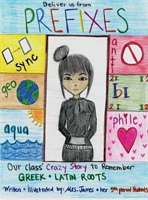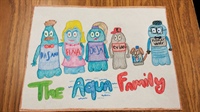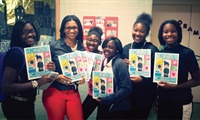56% F.
That was the highest score earned on the prefixes pre-test I gave my eighth graders at the beginning of the school year. You read that right: highest score! That means they all failed! Every. Single. One of them.
I was totally freaked. Greek & Latin Roots was not only a Common Core State Standard and a huge part of word recognition, but these students were expected to reach Mastery level on this standard by the end of the year. Mastery level seemed pretty ambitious when seven students received a 0% on the pre-test. Needless to say, we had a lot of work to do.
The Root Cause
Across the board, many students struggle with Greek & Latin Roots. In fact, each year on our state tests in reading, the students in our school always scored lowest on the Vocabulary standard. It was not because the students had never learned prefix meanings or that our awesomely fabulous Mrs. Siebert (sixth grade) and Mrs. Bond (seventh grade) ELA teachers weren’t awesome or fabulous enough.
Quite the contrary. The students did poorly simply because they did not remember what they learned. They were taught but it wasn’t caught. They remembered learning it, but it wasn’t memorable learning.
As teachers, we can be fabulous; we can teach awesome lessons and give homework every night of the week. But if the students don’t remember the concepts we’ve taught them, our hard work is the truest definition of “in vain.”
Thinking Back
I know I’m preaching to the choir. It’s often a struggle to find interesting ways to help our students find lasting success with remembering prefix meanings, since flash cards, rote memorization, and weekly vocabulary tests haven’t proven effective in the long run.

The students created an illustrated book to pass down to younger students..
I started thinking about the things I still remembered from my grade school lessons. At age 32, I still remembered the quadratic formula because Mrs. Dase taught it to us in the tune of the song “Frosty the Snow Man.” I still remember all states and capitals because my Aunt Karen helped me study, and we made up a dance to remember the ones I didn’t know. I still remember the parts of a cell and their functions because Mr. Wiand taught me while reciting the lyrics to Sir Mix-A-Lot’s 1990s hit, “Baby Got Back.”
If I wanted my students to learn, retain, and be able to actually apply their Greek & Latin Roots, I’d have to come up with something rigorous but hilarious. It would have to be challenging, but creative; engaging as well as entertaining.
Our Process
I decided to turn each prefix or root word on our eighth grade list (generated by the reading department at our school) into a person, place, thing, event, or idea. For example, meet the Aqua Family:
Dasani & Fina (short for Aquafina) lived near the ocean with their children: Deja (16) and Evian (12), and their dog Figi. Dasani & Fina didn’t approve of Deja’s new boyfriend Kroger Brand as they considered him cheap and generic (no shade Kroger, no shade).

The Aqua Family helps students make the connection between the aqua prefix and water.
Students may forget that aqua means water, but they probably won’t forget the Aqua Family. They recognize that an “aquarium” is a glass tank full of water. When they were discovering “aquatic” plants in science class, they connected that the plants grow in water. If they were taking a state test and didn’t know what an aquaculturist was, they were able at least to give their best guess knowing that it must have something to do with water.
Our goal was to create an illustrated story that we could pass down to the sixth and seventh graders to help them learn prefixes and root words. We applied the creative process to each of the more than 30 prefixes and root words on our eighth grade list.
The students and I spent many days brainstorming the plot of our story and making sure our illustrations were just right. Creating this story brought us together in the most authentic way, laughing and shaking our heads at the absurdity and ridiculousness of the ideas we’d come up with. Although I might be inclined to disagree with a proposed idea because of its craziness, I’d quickly change my mind and accept it, realizing that the craziness not only helped them remember, but it was what made it ours.
Beyond the Walls
Working on this project together allowed the kids who were hardly ever recognized in school to showcase their amazing artistry, and the girls who were known for their loudness and obnoxious behavior to channel it into something creative and special.

For this hands-on project, every student played a part in developing and publishing the book.
For this project, everybody got to play. Some students helped with writing and story transitions while others worked on character development and plot twists. Some drew, others colored; some edited, others produced; but everybody contributed. Without realizing it, while creating this story, the students were learning about plot, climax, rising action, characterization, author’s purpose, point of view, and so many other literary elements—not to mention the level of cooperative learning, teamwork, and creativity that took place every day. Each student became a confident leader, a higher-level thinker, and a better writer.
Our original intention was to pass this story down to the sixth and seventh graders in our building. As the story progressed, we soon realized that it could help students far beyond our school’s four walls. We published the book, which we called Deliver Us from Prefixes™, and found immediate success. Check it out at www.DeliverusfromPrefixes.com. Not only are other students now reading our book, but teachers are using it in their classrooms as a learning tool. We have received messages from other classes who are creating their own stories from their school’s prefix lists along with many requests to create a sequel: Deliver Us from Suffixes™.
Giving Back
Proceeds from our book benefit Heifer International, an outstanding charity that supports young girls in poverty stricken areas such as Nepal.
Publishing this book has also become a catalyst for the class’ literature-born activism. After reading Sold by Patricia McCormick, our students felt compelled to help educate, support, and rescue young girls from human trafficking and inhumane working environments. Sold and Half the Sky, by Nicholas Kristof and Sheryl WuDunn, provided awareness on a global level and turned our girls into immediate activists.
It is beyond an honor for us to give back in even the smallest way.
Because You Want to Know
Finally, I must mention that when these students took their prefix post-test after working on this story, the lowest score was a 100%. You read that right: lowest. That means that they all got an A+. Every. Single. One of them.
To gild the lily a bit, that year my students also scored a 95.6% on their Reading Ohio Achievement Assessment. That was the highest score in the entire school in any subject by more than 10% and definitely a school record. Holla!
Rashaun James is an eighth grade English teacher at Columbus City Preparatory School for Girls. rjames6097@columbus.k12.oh.usp @mrsrcjames www.deliverusfromprefixes.com
Published in AMLE Magazine, February 2015.
